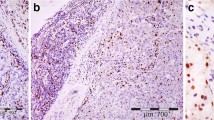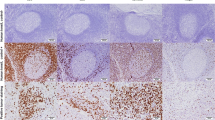Abstract
The prognostic significance of tumor-associated FOXP3+ regulatory T cells (Tregs) and CD8+ cytotoxic T lymphocytes (CTLs) in invasive breast carcinomas is studied. Tregs and CTLs were assessed by immunohistochemistry in 1270 cases of invasive breast carcinoma for their associations with patient survival, histopathologic features, and molecular subtypes. Infiltrates of Tregs and CTLs were observed within tumor bed and in the tissue surrounding tumor. Within tumor bed, increased infiltration of Tregs and CTLs was significantly more common in those with unfavorable histologic features, including high histologic grade and negative ER and PR status. In addition, high density Treg infiltration was also associated with tumor HER2 overexpression, decreased overall survival (OS) and progression-free survival (PFS). In tissue surrounding tumor, in contrast, high CTL/Treg ratio was found to be significantly associated with improved OS and PFS. These prognostic associations were confirmed by multivariate analysis. Furthermore, the density of Treg infiltrates within tumors was inversely correlated with the prognosis of the molecular subtypes of tumors. The ratio of CTL/Treg infiltrates in the surrounding tissue was also significantly higher in luminal than non-luminal subtypes of carcinoma. The prognostic significances of Tregs and CTLs in breast carcinoma depend on their relative density and location. The density of intratumoral Treg infiltrates and the peritumoral CTL/Treg ratio are independent prognostic factors and correlated with the prognosis of the molecular subtypes of breast carcinoma, which may serve as potential target for stratifying immunotherapy to battle against the aggressive subtypes of breast carcinoma.




Similar content being viewed by others
References
Galon J, Costes A, Sanchez-Cabo F et al (2006) Type, density, and location of immune cells within human colorectal tumors predict clinical outcome. Science 313:1960–1964
Parmiani G (2005) Tumor-infiltrating T-cells—friend or foe of neoplastic cells? N Engl J Med 353:2640–2641
Chiou SH, Sheu BC, Chang WC, Huang SC, Ho HN (2005) Current concepts of tumor-infiltrating lymphocytes in human malignancies. J Reprod Immunol 67:35–50
Yu P, Fu YX (2006) Tumor-infiltrating T lymphocytes: friends or foes? Lab Invest 86:231–245
Unitt E, Rushbrook SM, Marshall A et al (2005) Compromised lymphocytes infiltrate hepatocellular carcinoma: the role of T-regulatory cells. Hepatology 41:722–730
Guo XJ, Fan Y, Lang RG et al (2008) Tumor infiltrating lymphocytes differ in invasive micropapillary carcinoma and medullary carcinoma of breast. Mod Pathol 21:1101–1107
Pages F, Berger A, Camus M et al (2005) Effector memory T cells, early metastasis, and survival in colorectal cancer. N Engl J Med 353:2654–2666
Zhang L, Conejo-Garcia JR, Katsaros D et al (2003) Intratumoral T cells, recurrence, and survival in epithelial ovarian cancer. N Engl J Med 348:203–213
Leong PP, Mohammad R, Ibrahim N et al (2006) Phenotyping of lymphocytes expressing regulatory and effector markers in infiltrating ductal carcinoma of the breast. Immunol Lett 102:229–236
Baxevanis CN, Dedoussis GV, Papadopoulos NG, Missitzis I, Stathopoulos GP, Papamichail M (1994) Tumor specific cytolysis by tumor infiltrating lymphocytes in breast cancer. Cancer 74:1275–1282
Curiel TJ (2007) Tregs and rethinking cancer immunotherapy. J Clin Invest 117:1167–1174
Zou W (2006) Regulatory T cells, tumour immunity and immunotherapy. Nat Rev Immunol 6:295–307
Curiel TJ, Coukos G, Zou LH et al (2004) Specific recruitment of regulatory T cells in ovarian carcinoma fosters immune privilege and predicts reduced survival. Nat Med 10:942–949
Annunziato F, Cosmi L, Liotta F et al (2002) Phenotype, localization, and mechanism of suppression of CD4(+)CD25(+) human thymocytes. J Exp Med 196:379–387
Xu L, Xu W, Jiang Z, Zhang F, Chu Y, Xiong S (2009) Depletion of CD4(+)CD25(high) regulatory T cells from tumor infiltrating lymphocytes predominantly induces Th1 type immune response in vivo which inhibits tumor growth in adoptive immunotherapy. Cancer Biol Ther 8:66–72
Sato E, Olson SH, Ahn J et al (2005) Intraepithelial CD8(+) tumor-infiltrating lymphocytes and a high CD8(+)/regulatory T cell ratio are associated with favorable prognosis in ovarian cancer. Proc Natl Acad Sci USA 102:18538–18543
Kobayashi N, Hiraoka N, Yamagami W et al (2007) FOXP3(+) regulatory T cells affect the development and progression of hepatocarcinogenesis. Clin Cancer Res 13:902–911
Gao Q, Qiu SJ, Fan J et al (2007) Intratumoral balance of regulatory and cytotoxic T cells is associated with prognosis of hepatocellular carcinoma after resection. J Clin Oncol 25:2586–2593
Hiraoka N, Onozato K, Kosuge T, Hirohashi S (2006) Prevalence of FOXP3(+) regulatory T cells increases during the progression of pancreatic ductal adenocarcinorna and its premalignant lesions. Clin Cancer Res 12:5423–5434
Alvaro T, Lejeune M, Salvado MT et al (2005) Outcome in Hodgkin’s lymphoma can be predicted from the presence of accompanying cytotoxic and regulatory T cells. Clin Cancer Res 11:1467–1473
Dieu-Nosjean MC, Antoine M, Danel C et al (2008) Long-term survival for patients with non-small-cell lung cancer with intratumoral lymphoid structures. J Clin Oncol 26:4410–4417
Salama P, Phillips M, Grieu F et al (2009) Tumor-infiltrating FOXP3+ T regulatory cells show strong prognostic significance in colorectal cancer. J Clin Oncol 27:186–192
Bates GJ, Fox SB, Han C et al (2006) Quantification of regulatory T cells enables the identification of high-risk breast cancer patients and those at risk of late relapse. J Clin Oncol 24:5373–5380
Bohling SD, Allison KH (2008) Immunosuppressive regulatory T cells are associated with aggressive breast cancer phenotypes: a potential therapeutic target. Mod Pathol 21:1527–1532
Gobert M, Treilleux I, Bendriss-Vermare N et al (2009) Regulatory T cells recruited through CCL22/CCR4 are selectively activated in lymphoid infiltrates surrounding primary breast tumors and lead to an adverse clinical outcome. Cancer Res 69:2000–2009
Elston CW, Ellis IO (1991) Pathological prognostic factors in breast cancer. I. The value of histological grade in breast cancer: experience from a large study with long-term follow-up. Histopathology 19:403–410
Cheang MC, Chia SK, Voduc D et al (2009) Ki67 index, HER2 status, and prognosis of patients with luminal B breast cancer. J Natl Cancer Inst 101:736–750
Voduc KD, Cheang MC, Tyldesley S, Gelmon K, Nielsen TO, Kennecke H (2010) Breast cancer subtypes and the risk of local and regional relapse. J Clin Oncol 28:1684–1691
Grabenbauer GG, Lahmer G, Distel L, Niedobitek G (2006) Tumor-infiltrating cytotoxic T cells but not regulatory T cells predict outcome in anal squamous cell carcinoma. Clin Cancer Res 12:3355–3360
Nakano O, Sato M, Naito Y et al (2001) Proliferative activity of intratumoral CD8(+) T-lymphocytes as a prognostic factor in human renal cell carcinoma: clinicopathologic demonstration of antitumor immunity. Cancer Res 61:5132–5136
La Rocca G, Anzalone R, Corrao S et al (2008) CD1a down-regulation in primary invasive ductal breast carcinoma may predict regional lymph node invasion and patient outcome. Histopathology 52:203–212
Matkowski R, Gisterek I, Halon A et al (2009) The prognostic role of tumor-infiltrating CD4 and CD8 T lymphocytes in breast cancer. Anticancer Res 29:2445–2451
Acknowledgments
Research supported by grants from the National Natural Science Foundation of China (Grant No. 30930038), National “973” Program of China (Grant Nos. 2009CB521700; 2009CB918903) and the Program for Changjiang Scholars and Innovative Research Team in University (Grant No. IRT0743). We gratefully acknowledge Professor Wei Zheng, MD, PhD, Division of Epidemiology, Department of Medicine, Vanderbilt Epidemiology Center, Vanderbilt–Ingram Cancer Center, Vanderbilt University, Nashville, TN, USA, for his criticism on reviewing the article.
Conflict of interest
No conflicts of interest were declared.
Author information
Authors and Affiliations
Corresponding author
Rights and permissions
About this article
Cite this article
Liu, F., Lang, R., Zhao, J. et al. CD8+ cytotoxic T cell and FOXP3+ regulatory T cell infiltration in relation to breast cancer survival and molecular subtypes. Breast Cancer Res Treat 130, 645–655 (2011). https://doi.org/10.1007/s10549-011-1647-3
Received:
Accepted:
Published:
Issue Date:
DOI: https://doi.org/10.1007/s10549-011-1647-3




